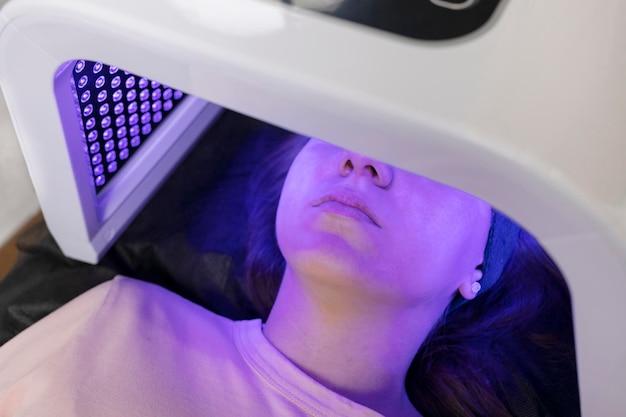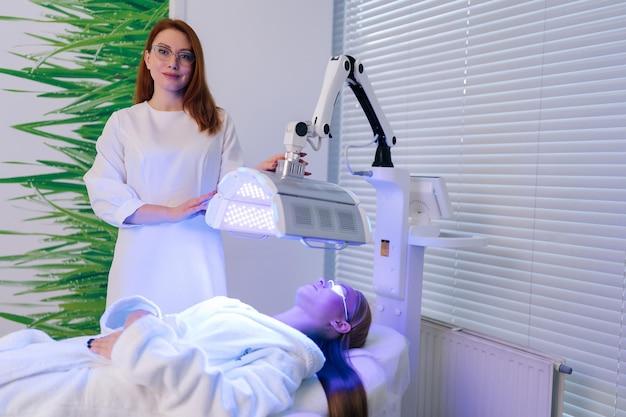LED Light Therapy is revolutionizing the world of skincare and wellness by offering a multitude of benefits that go beneath the surface to rejuvenate and heal the skin. This non-invasive treatment harnesses the power of light to trigger biological processes that help skin look younger, clearer, and more radiant. The question is not whether this technology can aid in improving skin health, but rather how extensive its benefits are. Delving into light therapy reveals its potential to combat acne, reduce wrinkles, and even improve mood. In this article, we illuminate the myriad advantages LED light therapy provides, and why it might just be the secret weapon in your beauty arsenal.
What is LED Light Therapy?

LED (Light Emitting Diode) therapy uses specific wavelengths of light to stimulate different responses in the skin. Unlike UV rays, the light emitted by these devices is not harmful to skin cells. In fact, this technology has been widely researched and used in various medical treatments, including wound healing and joint pain relief. This technology works by sending energy-producing packets of light into the deeper layers of the skin, which can lead to various positive skin outcomes.
The Science Behind LED Light Therapy

Understanding the science behind LED light therapy is crucial to appreciating its benefits. When the skin absorbs light, photoreceptors within cells are activated, producing energy that can facilitate the natural skin healing process. The particular spectrum and wavelength of the light determine the skin’s response, which is why different colors of LED lights target different skin issues.
How Does LED Light Therapy Work?
An LED light therapy device sends light waves deep into the skin to trigger natural intracellular reactions. As these wavelengths are absorbed, they promote different types of cell processes. For instance, red light is known for its anti-inflammatory and collagen-boosting properties, whereas blue light is effective against bacteria that cause acne.
The Different Colors of Light and Their Functions
The spectrum of light used in LED therapy ranges from blue to red, with each color providing specific benefits. The chromatic scale matters immensely, as each hue penetrates the skin to varying depths and has different effects.
Red Light for Rejuvenation
Red light is celebrated for its ability to stimulate collagen production, ultimately resulting in firmer, smoother skin. It has been proved to reduce inflammation and redness, making it an excellent option for those looking to combat signs of aging.
Blue Light for Battling Bacteria
Blue light targets and destroys acne-causing bacteria residing in the pores. This can result in a significant reduction of acne outbreaks, helping maintain clear and healthy skin.
Green Light for Pigmentation Issues
Green light is known for its calming effects on the skin. It can help alleviate pigmentation issues, such as sunspots or melasma, by targeting melanocytes, the cells responsible for pigmentation.
Health and Beauty Benefits of LED Light Therapy
LED light therapy is a non-invasive treatment that uses different wavelengths of light to visibly improve and rejuvenate skin. Each color of light targets specific cells and can have various effects from reducing wrinkles to easing pain. Here are some of the key benefits:
- Reduces Signs of Aging:Red light stimulates collagen production, which can reduce wrinkles and make skin firmer and smoother.
- Promotes Wound Healing and Tissue Repair:Red LED light not only improves skin appearance but also accelerates the healing process by promoting cellular repair and increasing circulation.
- Treats Acne:Blue LED light is used to treat acne by targeting the bacteria that cause acne infections, thus reducing acne and preventing new breakouts.
- Decreases Inflammation:Infrared light can penetrate deeper into the skin and tissue to reduce inflammation and pain in muscles and joints.
- Improves Skin Tone and Texture:Consistent use of LED therapy can improve overall skin tone and texture, leaving it glowing and rejuvenated.
- Safe for All Skin Types:LED light therapy is gentle, safe, and suitable for all skin types. It does not use UV light, making it a safe option for regular use.
Professional vs. At-Home LED Light Therapy Devices
When considering LED light therapy, one must choose between professional treatments at a clinic or using at-home devices. Both options have their advantages and considerations. Below is a comparison to help you make an informed decision.
What to Consider When Choosing a Device
Whether you’re contemplating an in-office treatment or investing in a home device, factors like cost, convenience, and intensity of the treatment play significant roles in your choice.
Here’s a table to illustrate the key differences between professional and at-home LED Light Therapy devices:
| Aspect | Professional Devices | At-Home Devices |
|---|---|---|
| Intensity | Higher, providing more potent treatments | Lower, designed for safe usage |
| Cost | More expensive per session | One-time purchase with potential for long-term savings |
| Convenience | Requires appointments and travel | Can be used at any time from the comfort of home |
| Expertise | Administered by trained professionals | User-friendly with guidance provided by manufacturers |
Preparing Your Skin for LED Light Therapy
Proper preparation is crucial to maximize the effectiveness of LED light therapy. Before undergoing LED treatment, ensure your skin is clean and free of any makeup, oils, or skincare products that could interfere with the light’s ability to penetrate the skin. It’s recommended to use a gentle, non-irritating cleanser to remove all debris and residues. This ensures that the light waves can reach the targeted cells without any barriers.
If you are using a treatment at a clinic, the aesthetician may also perform a light exfoliation to remove dead skin cells and enhance light absorption. Avoid using any potentially photosensitizing products, such as those containing retinol or citrus oils, several days prior to the session to reduce the risk of adverse reactions. Additionally, make sure your skin is completely dry before starting the therapy, as water can reflect light and reduce the treatment’s efficacy.
Conclusion
The illuminating effects of LED light therapy extend beyond mere skin-deep beauty. Its non-invasive nature, coupled with the diverse benefits for various skin concerns, makes it an enticing option for those seeking a rejuvenating skin treatment. By following the outlined practices and considering professional advice, individuals can safely pursue a healthier, more radiant complexion through LED light therapy.
Frequently Asked Questions
Here are some common queries people have about LED light therapy, answered to help you make informed decisions about incorporating this treatment into your routine.
What is the optimal duration and frequency for LED light therapy sessions?
While the optimal duration varies based on the device and your skin’s needs, most sessions last between 10 to 20 minutes and can be done up to three times a week for the best results.
Can LED light therapy damage my eyes?
Most home devices are designed to be safe for your eyes, but wearing safety goggles during treatment is a good precaution to take.
How long will it take to see the results from LED light therapy?
Results vary, but many people begin to notice improvements after 4 to 6 weeks of consistent use.
Is LED light therapy safe for all skin types?
Yes, it is generally safe for all skin types, but those with sensitive conditions should consult a dermatologist beforehand.
Can I use LED light therapy with other skincare treatments?
Yes, in many cases, LED light therapy can be combined with other treatments, but you should allow time for skincare products to absorb and consult a professional when using photosensitive medications.
